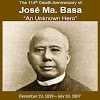The province of Negros Occidental once again commemorated its Environment Week last week, and several seal of good environmental governance awards were given to various institutions, from both government and non-governments organizations.
The provincial government, through the Provincial Environment and Management Office, spearheaded the commemoration, in partnership with local governments, academic institutions, business and private sectors and nongovernment and people’s organizations.
While it is encouraging to note that there are concrete efforts being done to address numerous environmental challenges and concerns, the question remains if indeed we are winning the campaign against environmental destruction in Negros Occidental?
At the height of the Environment Week’s celebration, the issue on forest destruction in southern Negros Occidental resurfaced, and this time in a much greater magnitude, because, as reported in this paper, the remaining wilderness area in Hinoba-an town has almost been totally wiped out through the years of illegal timber poaching.
Local officials and officers of the Department of Environment and Natural Resources expressed dismay and outrage of this reality and promised to take concrete actions, but unfortunately, the damage have already been inflicted. I am not sure if we will be able to restore the almost 300 hectares of destroyed natural forest.
The wilderness area, covering almost 300 hectares, in Sitio Wilderness, Barangay Damutan in Hinobaan town was a natural forest that had been spared from the logging concession of the defunct Insular Lumber Co. If my memory serves me right, it was an experimental research and laboratory station of the then Forest Research Institute of the Bureau of Forestry (now the Ecosystems Research and Development Bureau of the DENR).
The area contained assorted and numerous dipterocarp species, such as lauan, apitong, tangile and other biologically important species. Before it was destroyed, this wilderness area was the largest intact forest in southern Negros Occidental, which also served as the natural habitat of threatened species, like the endemic Philippine spotted deer and Visayan warty pigs, among others. What has been left in the area is only about 14 hectares and this remaining forest stand remains unsecured.
Provincial Environment and Natural Resources Officer Andres Untal was quoted in this paper saying that the illegally sourced trees were transported through rafting in the Culipapa and Basay rivers in Hinobaan and in adjacent Bayawan town in Negros Oriental, respectively, and sold to fisherfolk for use in making boat hulls.
Untal estimated the total volume of cut trees to about 400,000 to 500,000 board feet with a market value of almost P16 million. He believes that a big-time financier is behind this illegal operation. Hinobaan Mayor Ernesto Estrao claimed that the cutting of trees in the wilderness area has been going on for the past several years. Governor Alfredo Marañon Jr. vowed to file charges against those behind the forest destruction.
It is unfortunate though that in spite the knowledge of DENR and local officials that this operation has been going on for several years, there was no concrete action to protect the wilderness area, and they only come to realize when the forest in the site is almost gone. Are we doing the real and serious forest protection mission?* (To be continued)









0 Comments